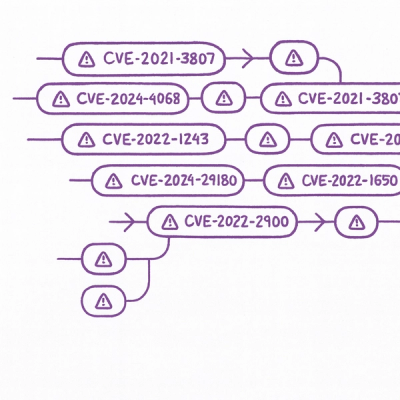
Security News
New Website “Is It Really FOSS?” Tracks Transparency in Open Source Distribution Models
A new site reviews software projects to reveal if they’re truly FOSS, making complex licensing and distribution models easy to understand.
Make PDF generation a breezy-easy.
No binaries to install. No reinventing the wheel to match HTML layouts. Just simple HTML to PDF generation as a Rack Middleware with support for modern CSS and JavaScript. .pdf any of your app's URL's for fast, out-of-process, PDF generation of that URL. Support for public and authenticated views, local development and production.
Sign Up for an account to get started.
View the Demo and the Demo's Source Code
Add this line to your application's Gemfile:
gem 'breezy_pdf'
And then execute:
$ bundle
Or install it yourself as:
$ gem install breezy_pdf
To add the middleware:
# config/application.rb
BreezyPDF.secret_api_key = "YOUR_SECRET_API_KEY" # Remove if specified elsewhere
config.middleware.use BreezyPDF::Middleware
# view.html.erb
<%= link_to "Download as PDF", my_resource_path(format: :pdf) %>
Proceed to configuration.
To add the middleware:
# app.rb
BreezyPDF.secret_api_key = "YOUR_SECRET_API_KEY" # Remove if specified elsewhere
use BreezyPDF::Middleware
# view.html
<a href="/this/url.pdf">Download as PDF</a>
Proceed to configuration.
BreezyPDF supports extensive configuration for how want PDF's to render:
# config/initializers/breezy_pdf.rb
BreezyPDF.setup do |config|
# Secret API Key
#
# Obtain an API key from https://breezypdf.com
# Store your API key in a secure location with the rest of your app secrets
config.secret_api_key = "YOUR_SECRET_API_KEY"
# Middleware Path Matchers
#
# An array for Regular Expressions which identify which URL's should be
# intercepted by the Middleware. Defaults to [/\.pdf/], which will match
# all requests containing a .pdf extension.
# config.middleware_path_matchers = [/\.pdf/]
# Treat URL's as Private
#
# This indicates if the URL requested is protected or unaccessible for the
# public Internet. Examples of this would be when hosted on localhost (development)
# URL's which are protected by authentication, or URL's that depend on session/cookie
# data to display correctly. Default is true.
#
# config.treat_urls_as_private = true
# Upload Assets
#
# Express your desire to upload assets within the requested HTML which are not
# publicly accessible with a FQDN. This might include images, CSS, and
# JavaScript when running in development mode, or assets which are referenced
# with relative URL's. If you're able to turn this off, performance will be increased
# Default is true.
#
# Only applicable when `config.treat_urls_as_private == true`
#
# config.upload_assets = true
#
# or, if your assets are only publicly available on production
# config.upload_assets = Rails.env.development?
# Asset Selectors
#
# Configure what types of assets should be evaluated to be uploaded. Expects an
# array of string CSS selectors. Default is `[img script link[rel="stylesheet"]]`.
#
# Only applicable when `config.treat_urls_as_private == true`
# Only applicable when `config.upload_assets == true`
#
# config.asset_selectors = %w(img script link[rel="stylesheet"])
# Asset path matchers
#
# Determine which attribute path's to replace with an uploaded version of the asset.
# Expects a hash of attr: Regexp values. Default is `{ href: /^\/\w+/, src: /^\/\w+/}`
# which matches all relative paths.
#
# Only applicable when `config.treat_urls_as_private == true`
# Only applicable when `config.upload_assets == true`
#
# config.asset_path_matchers = {
# href: %r{^\/\w+},
# src: %r{^\/\w+}
# }
# Asset Cache
#
# Cache asset URL's to prevent re-uploading of assets. Assets are cached based on asset_path,
# so fingerprinting or digests are recommended before turning on. The default cache store is
# a null store, which won't actually store anything. An in-memory store is also provided, but
# this store won't share values across threads. Alternatively, use an external store which
# implements a `fetch(key, opts={}, &blk) API, such as the Rails.cache.
#
# Only applicable when `config.treat_urls_as_private == true`
# Only applicable when `config.upload_assets == true`
#
# config.asset_cache = BreezyPDF::Cache::Null.new
#
# or
#
# config.asset_cache = BreezyPDF::Cache::InMemory.new
#
# or
#
# config.asset_cache = Rails.cache
# Extract Metadata
#
# BreezyPDF supports specifying how a page should be rendered through meta tags within
# the HTML to be rendered. Visit https://docs.breezypdf.com for metadata information. Default is
# true.
#
# Only applicable when `treat_urls_as_private == true`
# config.extract_metadata = true
# Threads
#
# Specify the maximum number of Threads to use when uploading assets. This speeds up the
# uploading of assets by doing them concurrently. Default is 1.
#
# Only applicable when `config.treat_urls_as_private == true`
# Only applicable when `config.upload_assets == true`
#
# config.threads = 1
#
# or
#
# config.theads = Concurrent.processor_count
# Filter Elements
#
# Remove certain elements from the HTML which shouldn't be included in the PDF, such as
# a navigation or footer elements. Default is false.
#
# Only applicable when `config.treat_urls_as_private == true`
#
# config.filter_elements = false
# Filter Elements Selectors
#
# CSS selectors to configure which element you'd like to remove. Expects an array of of
# CSS selectors. Default is `[.breezy-pdf-remove]`.
#
# Only applicable when `config.treat_urls_as_private == true`
#
# config.filter_elements_selectors = %w[.breezy-pdf-remove]
# Logger
#
# Configure the logger, if you're into that sort of thing.
#
# config.logger = Logger.new(STDOUT).tap { |logger| logger.level = Logger::FATAL }
# Default Meta Data
#
# Define default meta data which will be included with every render. Extracted metadata
# will override these values. Visit https://docs.breezypdf.com for metadata information.
#
# config.default_metadata = {
# width: 23.4,
# height: 33.1
# }
end
By default, the requested PDF will eventually returned by the request after a series of redirects. The PDF will be sent with a Content-Disposition of attachment, so the browser will attempt to download it instead of showing it inline. All the while, and after the PDF has been downloaded, the current page's HTML will continue to be displayed.
If you want to show a loading animation on the current page, you can simply load the PDF with an AJAX request, eventually redirecting to the final URL.
Here is a contrived example:
<a href="/this/path.pdf" class="pdf-link">Download as PDF</a>
<script type="text/javascript">
$('.pdf-link').on('click', function(clickEv) {
var startTime = new Date();
var targetEl = $(clickEv.target);
var modalEl = $('#pdf-loading'); // An existing bootstrap modal in this example
var ajaxRequest = new XMLHttpRequest();
clickEv.preventDefault();
ajaxRequest.addEventListener('load', function(ev) {
modalEl.modal('hide');
window.location = ev.currentTarget.responseURL;
})
modalEl.modal('show');
ajaxRequest.open('GET', targetEl.attr('href'));
ajaxRequest.send();
})
</script>
You may want to render a PDF out of the HTTP request cycle like in a background job or mailer. BreezyPDF supports rendering HTML as a PDF pragmatically. BreezyPDF::HTML2PDF expects two arguments, the asset_host for assets, and the html fragment. The asset_host should be the locally accessible host where external assets (js, css) can be downloaded from. In development, this may be http://localhost:3000, while in production it may be your configured Rails.application.config.action_controller.asset_host. If BreezyPDF.upload_assets == false, then this value has no impact.
Here is an example of how you might do that:
def invoice_mailer(user, invoice)
asset_host = Rails.env.production? ? Rails.application.config.action_controller.asset_host : "http://localhost:3000"
metadata = { width: 8.5, width: 11 }
renderer = ApplicationController.renderer.new(https: true)
html = renderer.render(template: "invoices/show", assigns: { invoice: invoice }, locals: { current_user: user })
pdf = BreezyPDF::HTML2PDF.new(asset_host, html, metadata)
attachments["invoice-#{invoice.id}.pdf"] = pdf.to_file.read
@pdf_url = pdf.to_url
end
This example uses ActionController::Renderer to render a controller template's html.
After checking out the repo, run bin/setup to install dependencies. Then, run rake test to run the tests. You can also run bin/console for an interactive prompt that will allow you to experiment.
To install this gem onto your local machine, run bundle exec rake install. To release a new version, update the version number in version.rb, and then run bundle exec rake release, which will create a git tag for the version, push git commits and tags, and push the .gem file to rubygems.org.
Bug reports and pull requests are welcome on GitHub at https://github.com/danielwestendorf/breezy_pdf.
Copyright (c) Daniel Westendorf
BreezyPDF is an Open Source project licensed under the terms of the LGPLv3 license. Please see http://www.gnu.org/licenses/lgpl-3.0.html for license text.
FAQs
Unknown package
We found that breezy_pdf demonstrated a not healthy version release cadence and project activity because the last version was released a year ago. It has 1 open source maintainer collaborating on the project.
Did you know?

Socket for GitHub automatically highlights issues in each pull request and monitors the health of all your open source dependencies. Discover the contents of your packages and block harmful activity before you install or update your dependencies.

Security News
A new site reviews software projects to reveal if they’re truly FOSS, making complex licensing and distribution models easy to understand.

Security News
Astral unveils pyx, a Python-native package registry in beta, designed to speed installs, enhance security, and integrate deeply with uv.

Security News
The Latio podcast explores how static and runtime reachability help teams prioritize exploitable vulnerabilities and streamline AppSec workflows.